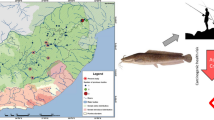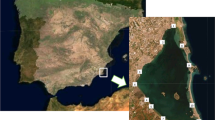Abstract
In the period 1999–2003 a monitoring study on the accumulation of organotin compounds in edible organisms in the Lagoon of Venice was conducted. Butyl and Phenyl derivatives were determined in pooled samples of Mytilus galloprovincialis and Tapes spp. with the aims of assessing organotin contamination in the Lagoon of Venice in the period just preceding their ban in Europe, monitoring the concentrations in organisms with a high commercial use, evaluating a potential hazard for human health due to seafood and identifying the possible contamination sources. Sampling stations (up to 20) were distributed around the Lagoon and particularly concentrated in the area close to the town of Chioggia. Significantly higher (analysis of variance (ANOVA), p<0.05) tributyltin (TBT) concentrations were found in mussels (from 38 ±8 to 6,666 ±1,333 μg kg−1 d.w., as TBT+), than in clams (from 6 ±1 to 2,256 ±451 μg kg−1 d.w., as TBT+). During the 3 years of the survey no increase in average concentrations of the butyltin compounds (tributyltin (TBT) + dibutyltin (DBT) + monobutyltin (MBT)) was observed (ANOVA, p>0.05) in either species. Furthermore, by analyzing the entire data set, it is evident that most stations show analogous concentrations in the 3 years for both species, whereas few have anomalously higher concentrations. If organotin concentrations in specimens from some sites are compared with the Tolerable Average Residue Level, a possible risk for human health must be considered.
Similar content being viewed by others
References
Alzieu, C. (1989). L’etain et les organoetains en milieu marin: Biogeochimie et Ecotoxicologie. Rapport scientifique et technique de l’IFREMER, 17, 1–93.
Alzieu, C. (1998). Tributyltin: case study of a chronic contaminant in the coastal environment. Ocean & Coastal Management, 40, 23–36.
Antizar-Ladislao, B. (2008). Environmental levels, toxicity and human exposure to tributyltin (TBT)-contaminated marine environment. A review. Environment International, 34, 292–308.
Axiak, V., Vella, A. J., Micaleff, D., & Chrcop, P. (1995). Imposex in Hexaplex trunculus: first results from biomonitoring of TBT contamination in the Mediterranean. Marine Biology, 121, 685–691.
Barnes, J. M., & Magos, L. (1986). Toxicology of organometallic compounds. Organometallic Chemistry Review, 3, 137–150.
Barroso, C. M., Mendo, S., & Moreira, M. H. (2004). Organotin contamination in the mussel Mytilus galloprovincialis from Portuguese coastal waters. Marine Pollution Bulletin, 48, 1149–1153.
Belfroid, A. C., Purperhart, M., & Ariese, F. (2000). Organotin level in Seafood. Marine Pollution Bulletin, 40, 226–232.
Bortoli, A., Troncon, A., Dariol, S., Pellizzato, F., & Pavoni, B. (2003). Butyltins and phenyltins in biota and sediments from the Lagoon of Venice. Oceanologia, 45, 7–23.
Boscolo, R., Cacciatore, F., Berto, D., Marin, M. G., & Giani, M. (2004). Contamination of natural and cultured mussels (Mytilus galloprovincialis) from the Northern Adriatic Sea by tributyltin and dibutyltin compounds. Applied Organometallic Chemistry, 18, 614–618.
Bressa, G., & Cima, L. (1985). Lo stagno e i suoi composti organici (parte I). Ambiente risorse e salute, 46, 45–47.
Bryan, G. W., Gibbs, P. E., Burt, G. R., & Hummerstone, L. G. (1987). The effect of tributyltin (TBT) accumulation on adult dog-whelks, Nucella lapillus: long-term field and laboratory experiments. Journal of Marine Biological Association of the UK, 67, 525–544.
Bryan, G. W., Gibbs, P. E., Hummerstone, L. G., & Burt, G. R. (1986). The decline of the gastropod Nucella lapillus around the south-west of England: evidence for the effect of tributyltin from antifouling paints. Journal of Marine Biological Association of the UK, 66, 611–640.
Cáceres-Martínez, J., & Figueras, A. (1998). Long-term survey on wild and cultured mussels (Mytilus galloprovincialis Lmk) reproductive cycles in the Ria de Vigo (NW Spain). Aquaculture, 162, 141–156.
Davies, A. G., & Smith, P. J. (1982). Tin. In G. Wilkinson (Ed.), Comprehensive organometallic chemistry. The Synthesis, Reaction and Strucures of Organometallic Compounds (vol. 2, (p. 19)). New York: Pergamon.
Evans, C. J. (1974). Developments in the organotin industry. 2. Diorganotin compounds. Tin and its uses, 101, 12–15.
Gallina, A., Magno, F., Tallandini, L., Passaler, T., Caravello, G. U., & Pastore, P. (2000). Simple and effective gas chromatographic mass spectrometric procedure for the speciation analysis of organotin compounds in specimens of marine mussels. An evaluation of the organotin pollution of the Lagoon of Venice. Rapid Communications in Mass Spectrometry, 14, 373–378.
Goldberg, E. D. (1986). TBT: an environmental dilemma. Environment, 28, 17–44.
Hoch, M. (2001). Organotin compounds in the environment. An overview. Applied geochemistry, 16, 719–743.
Hoch, M., & Schwesig, D. (2004). Parameters controlling the partitioning of tributyltin (TBT) in aquatic systems. Applied geochemistry, 19, 323–334.
Kannan, K., Tanabe, S., Iwata, H., & Tatsukawa, R. (1995). Butyltins in muscle and liver of fish collected from certain Asian and Oceanian countries. Environmental Pollution, 90, 279–290.
Lubet, P., Brichon, G., Besnard, J. Y., & Zwingelstein, G. (1985). Composition and metabolism of lipids in some tissues of the mussel Mytilus galloprovincialis L. (Moll. bivalvia)—in vivo and in vitro incorporation of 1(3)-[3H]-glycerol. Comparative Biochemistry and Physiology Part B: Biochemistry and Molecular Biology, 82, 425–431.
Maguire, R. J. (1987). Environmental aspects of tributyltin. Applied Organometallic Chemistry, 1, 475–498.
Morabito, R. (1995). Speciation of organotin in environmental matrices. Microchemical Journal, 51, 198–206.
Morcillo, Y., Borghi, V., & Porte, C. (1997). Survey of organotin compounds in the western Mediterranean using molluscs and fish as sentinel organisms. Archives of Environmental Contamination Toxicology, 32, 198–203.
Morcillo, Y., & Porte, C. (1998). Monitoring of organotin compounds and their effects in marine molluscs. Trends in Analytical Chemistry, 17, 109–116.
Nemanič, T., Leskovšek, H., Horvat, M., Vrišer, B., & Bolje, A. (2002). Organotin compounds in the marine environment of the Bay of Piran, Northern Adriatic Sea. Journal of Environmental Monitoring, 4, 426–430.
Penninks, A. H. (1993). The evaluation of data-derived safety factors for bis(tri-n-butyl)tin oxide. Food Additives and Contaminants, 10, 351–361.
Sedano, F. J., Rodríguez, J. L., Ruiz, C., García-Martín, L. O., & Sánchez, J. L. (1995). Biochemical composition and fertilization in the eggs of Mytilus galloprovincialis (Lamark). Journal of Experimental Marine Biology and Ecology, 192, 75–85.
Tanabe, S. (1999). Butyltin contamination in marine mammals—a review. Marine Pollution Bulletin, 39, 62–72.
US Department Of Health And Human Services (2005). Public Health Service Agency for Toxic Substances and Disease Registry. Toxicological profile for tin and tin compounds. Accessed http://www.atsdr.cdc.gov/toxprofiles/tp55.pdf
Author information
Authors and Affiliations
Corresponding author
Rights and permissions
About this article
Cite this article
Zanon, F., Rado, N., Centanni, E. et al. Time trend of Butyl- and Phenyl-Tin contamination in organisms of the Lagoon of Venice (1999–2003). Environ Monit Assess 152, 35–45 (2009). https://doi.org/10.1007/s10661-008-0294-6
Received:
Accepted:
Published:
Issue Date:
DOI: https://doi.org/10.1007/s10661-008-0294-6




